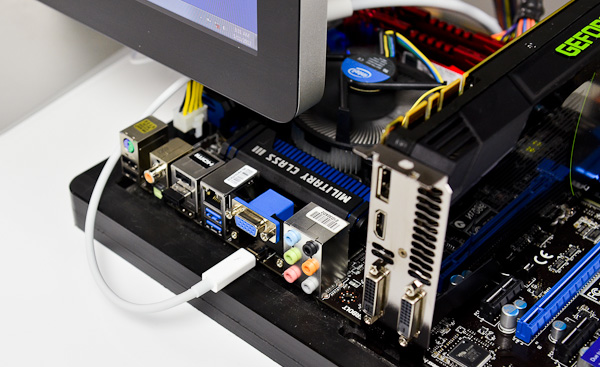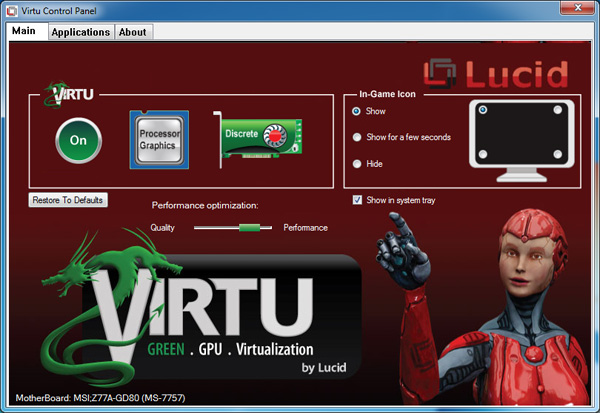A First Look at Thunderbolt on Windows with MSI's Z77A-GD80
by Anand Lal Shimpi on May 11, 2012 1:32 PM EST- Posted in
- Motherboards
- CPUs
- Intel
- MSI
- Thunderbolt
The Thunderbolt Display
The first test was hooking up Apple's Thunderbolt Display, the only Thunderbolt display device available on the market today. Although I shouldn't have been, I was a bit surprised when the display just worked. Intel's HD 4000 drove the 2560 x 1440 panel just fine and there weren't any funny issues displaying the lower res UEFI setup mode.
Despite Ivy Bridge being able to drive three independent displays, I was only able to simultaneously output to two connected displays on the GD80. All combinations of two worked however (TB + HDMI, TB + VGA, VGA + HDMI).
Once in Windows, the Thunderbolt Display's integrated GigE, Firewire and other controllers started popping up. Unfortunately Apple doesn't offer a direct download package for Thunderbolt Display drivers. You can either hunt down the controllers/drivers on their own, or you can build a Windows Support (driver) package using a Mac and the Boot Camp Assistant. I'd much rather Apple just offer an easy route for non-Mac Windows users to take advantage of the Thunderbolt Display as it's the only TB display on the market, but I can understand the lack of motivation there.
With the Boot Camp drivers installed, I got working GigE and Firewire 800. The Thunderbolt Display's integrated USB hub gave me issues however. Anything I plugged into it would either partially work (e.g. my mouse was detected but moving the cursor was far from smooth) or not work at all (e.g. my attached USB keyboard never worked). The other issue with the Thunderbolt Display is you get no brightness control, which can be a problem given how bright the panel gets. I've seen reports of people getting brightness control working via software tools but the solutions don't seem permanent.
Apple's Thunderbolt Display definitely works, but Windows users will likely want to wait for a Thunderbolt display that is built specifically with Windows in mind.
Virtu and Thunderbolt: It Works
From a software perspective, Thunderbolt is treated just like another display output driven by Intel's processor graphics. I installed a GeForce GTX 680 along with Lucid's Virtu GPU virtualization software to see if I could use the 680 for gaming but drive the display using Intel's processor graphics and the Thunderbolt port. The setup worked flawlessly.
Virtu recognized the configuration immediately once I had NVIDIA's drivers installed, and I was able to run the 680 headless - using only the Thunderbolt port to drive the external display. Intel's HD 4000 powered things in Windows, while the 680 kicked in for games.













98 Comments
View All Comments
AnTech - Saturday, May 12, 2012 - link
It should be possible to power on a computer from a Thunderbolt port, as was previously possible with Macs using a device like the i-Cue for USBhttp://www.lindy.co.uk/usb-boot-dongle-i-cue-for-m...
or the former ADB Apple keyboards that also allowed powering on the Mac from them. That is really convenient when the computer is away and difficult to reach, below the table, etc.
rikm - Saturday, May 12, 2012 - link
First page says: Co-developed by Apple and Intel, Thunderbolt is a tunnel that carries both PCIe and DisplayPort traffic to the tune of 20Gbps per channel (10Gbps up and down).Page 3 says: Total available bandwidth for a single-port Thunderbolt device is 20Gbps bi-directional (40Gbps total), so there's still additional headroom available.
Which is it?
KitsuneKnight - Saturday, May 12, 2012 - link
It's 10Gbps up or down per channel. So 20Gbps per channel.There's 2 channels, so there's a total, aggregate bandwidth of 40Gbps in both directions.
So it's both.
buzznut - Saturday, May 12, 2012 - link
This is a very vanilla looking board for around $200. And the PCI-express lanes are pathetic. They choose to implement Thunderbolt on a motherboard with how many lanes??I like msi so I really don't understand this. And for some reason, Intel motherboards in general don't provide enough PCIx lanes. As features are added, it seems like they limit the lanes even more. What gives?
In my opinion, someone would have to be pretty desperate to have Thunderbolt in their system if this board is representative of most implementations. Sure, its a new technology but this is indicative of a larger problem-Intel had the same problem with their implementation of USB 3.0; not enough PCI express lanes. A person would be foolish to use this board with crossfire or sli.
ggathagan - Saturday, May 12, 2012 - link
Why desperate ?I think many are not understanding ThunderBolt.
It's not a device in-and-of-itself, it's a flexible bus mechanism that's fairly protocol-independent.
You're viewing it as something that consumes x4 PCIe lanes, eliminating their use by another device.
That's not accurate.
In the case of this board, it allows you to use the 4x bandwidth for USB, firewire, SATA, DP, gigabit ethernet or any combination thereof.
If a motherboard vendor chose to do so, they could link it to a PCIe 3 x16 lane and still not utilize TB's full bandwidth.
Given the tests that show little or no difference in PCIe 2 x8 vs x16 performance, that opens a LOT of possibilities.
repoman27 - Sunday, May 13, 2012 - link
Ivy Bridge LGA 1155 CPU's provide 16 PCIe 3.0 lanes for dGPU use, which is pretty much twice the bandwidth that came with Sandy Bridge and plenty for most setups.The PCH continues to offer 8 PCIe 2.0 lanes for additional features, which is about all that is reasonable given the 20 Gbps limit of the DMI 2.0 connection to the CPU. The more features a motherboard manufacturer adds, the more of these lanes they consume, and the fewer that are left available to the end user as open PCIe slots. By my count, MSI have used 6 of the 8 lanes branching off of the PCH by adding Thunderbolt, FireWire and an additional SATA 6 Gbps controller.
If you really think 16 GB/s of bandwidth isn't enough for your particular CrossFire or SLI setup, you can always go with an LGA 2011 solution which would give you 40. The bottom line is that if you want more PCIe lanes, you need a bigger socket with a lot more pins to provide those connections, and that ain't cheap.
richard451 - Saturday, May 12, 2012 - link
It's odd that the article states multiple times that Thunderbolt does not need any drivers for the OS to take advantage of it, yet the update from Intel states once Windows gets updated Thunderbolt drivers things will improve.ggathagan - Saturday, May 12, 2012 - link
The comments about drivers from Intel revolve around extending hot-swap capability to TB-connected devices.Much like hot-swap AHCI is supported in Windows 7 while not in XP, the basic functionality for the connectivity in W7 is due to TB connections being seen as a PCIe device or a DP device in W7, while the hot-swap functionality has to be achieved through drivers.
I suspect Windows 8 might have said capability built in.
I doubt MS is interested in doing the same for W7, since they want us all to move forward on their 'enlightened' Metro path.
repoman27 - Sunday, May 13, 2012 - link
To clarify, the Thunderbolt controller does not require any drivers, but the devices you connect via Thunderbolt may.Thunderbolt devices tend to include PCIe hardware for which Windows drivers already exist, but the drivers were not designed with hot-plugging in mind. Once the drivers are tweaked to support hot-plugging, the devices won't require a restart in order to be recognized by the system, and will become eligible for Thunderbolt certification for Windows.
It's the drivers for the PCIe connected hardware in the Thunderbolt devices that need updating in order to work properly in the new Thunderbolt context.
SimoxTav - Saturday, May 12, 2012 - link
May I suggest to take a look at the performance videos of the eGPU solution listed on the topic?http://forum.notebookreview.com/8267588-post1.html
Check the "1.2Opt-Int" videos (scroll down) that means "x1 PCI 2.0 + Optimus Compression on internal screen". The results are IMHO quite enjoyable with a GTX560. With Thunderbolt can only be better (and easier to be implemented). Currently the performance are about 75-80% of the x16 counterpart (obviously depending on the specific game).